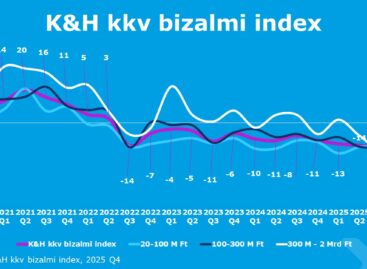The forecast of GKI Economic Research Co. for 2012
Hungary is lagging behind the EU in economic terms and is becoming isolated politically from the EU. According the latest figures GDP trends are the most unfavourable in Hungary following Greece and Portugal. The yields of government securities are higher only in these two countries (sometimes also in Ireland) than in Hungary. The rate of inflation, the reference rate of the central bank and the exchange rate volatility are the highest in Hungary in the CEE region. Deterioration in employment was hidden only in statistical terms by the increase of public work. Income and consumption of households are decreasing, investments are plummeting. Growing divergence in Hungary’s legal and institutional system from the norms of Western European type of market economy and in the way they are being run is leading to capital outflow. It is subject to wide-spread critics in the EU: The single successes include the decrease of general government deficit in 2012 and 2013 as well as the promise concerning the termination of the excessive deficit procedure by the EU next year. The positive effects of these successes are neutralised by negative trends, including the insistence of the government to wrong economic policy and institutional changes that caused the adverse developments. This is reflected in the policy of the government on negotiations with the IMF. In fact, the government seems to try to keep away the IMF from Hungary. The Hungarian economy is in grave recession.
Compared to the state of affairs in early 2012 that threatened with a money market financing crisis, the situation has eased recently but the government has not produced the preconditions of essential and lasting improvement. In the first half of June the exchange rate of the forint to the euro varied in the range of HUF295-HUF305, the CDS spread was about 600 basis point, following the recent Greek elections they dropped below HUF290 and 550 bps, respectively. The collapse of Greece and the postponement of the negotiations between the Hungarian government and the IMF were priced out of the money market. The Monetary Council in the National Bank of Hungary did not change its reference rate that had been 7 per cent since the latest rise in December 2011. (In May 2010 when the Bajnai government left office the exchange rate of the forint to the euro amounted to about HUF275, the CDS spread to less than 250 bps and the reference rate of the NBH to 5.25 per cent.)

With the uncertain global financial situation, the controversial management of the European debt crisis and the slowdown of capital flows, global growth is expected to slow down somewhat in 2012. The combined GDP of the EU is predicted to stagnate in 2012 compared with the 1.5 per cent growth in 2011. In Germany the rate of GDP growth is likely to fall from 3 per cent to 0.7 per cent. The main reason for this is the slowdown of external demand. The divergence of GDP growth rates are widening among EU member states (with Greece and Poland being the two extremes). Because of the catastrophic consequences the market government default, the euro-zone exit and the sharpening of social and political tensions will be avoided in Greece. Even a government default managed orderly by the EU is likely to keep markets in uncertainty for a rather long time. The critical public finances in Spain accelerated efforts in the EU to create a federative banking union. Its major aim is to build down the mutual relationship between government debt and bank debt in the long run, and to strengthen the confidence of money markets in the short term. Its essential part is the recapitalisation of solvent large banks, creation of supervision and deposit insurance system, at the level of the EU including the financial sources for funding. As a result of the government change in France the elaboration of a package stimulating economic growth was set on the agenda in the EU that should complement the consolidation of the general government. Measures taken in the framework of crisis management by member states narrow the room of manoeuvring of member states, intensify the role of EU institutions and European integration in general. In some countries that are in a favourable situation the extension of fiscal adjustment, in others changes in the structure of fiscal adjustment, at the level of the EU the economic and growth policy tailored to the needs of individual member states as well as the banking union may contribute to the stabilisation of the EU.
Monetary policy will remain loose. In the US further quantitative easing may take place. The European Central Bank may reduce slightly its reference rate (that is 1 per cent for the time being) in the third quarter of 2012 (to 0.75 per cent). The exchange rate of the euro to the US dollar is likely to average USD1.25 in 2012 against USD1.39 in 2011 with significant volatility. With the slowdown of the global economy the annual average per barrel price of Brent is predicted to drop from USD111 in 2011 to USD105 in 2012.
In Hungary expectation in the business sector and among households are characterised by deep pessimism, and the deterioration is more pronounced than in the EU. The evaluation of the Hungarian economy is very unfavourable.
The government that has been in office since May 2010 still does not have a clear economic policy. It has only a confrontational guideline that is not in line with the norms of the market economy and hurts the Hungarian constitution and EU legal rules. The government eliminated the checks and balances (such as the old constitution itself) that inhibit the exercise of power from one centre and pushed independent institutions out of decision making. The major objective of the government is to maintain the political power whose scope has been extended substantially and the position of beneficiary social and business groups. Following the dismantling of counterweights in rule of law, one of the last limiting factors is the capability of financing Hungary’s private and public debts. In 2012 the government will probably not conclude an agreement with the IMF, more precisely it will make small concessions in order to start or continue negotiations that are indispensable for the minimum confidence of market participants. Due to the much higher risk premium (about 200 bps) than possible under normal circumstances this is a very expensive tactics that may turn very dangerous in sharpening international financial market situations. Under the given circumstances the potential conclusion of the agreement with the IMF may involve limited advantages such as the access to external financing and the reduction of the unbearably high interest rate level. Since the content of the agreement would presumably involve only important corrections rather than a general turn and radical changes in the economic and legal institutional system and economic policy, the changes would not reach the critical mass that is necessary to improve Hungary’s capital absorption capacity and growth potential. In fact,
- with the exception of reducing the general government deficit below 3 per cent of GDP, none of the objectives of economic policy was achieved, only political power interests are attained;
- in the EU that is becoming more complex, integrated, multi-speedy and multi-level, the Hungarian government keeps its country at the lowest possible level of integration to defend its anti-democratic revolution. This way it produces huge losses to Hungary;
- the government does not pay attention to the fact that all economic actors (the state, businesses and households) finance their debts at much higher interest rates or exchange rates than otherwise possible. The additional burdens of this economic policy is borne by the business sector and households;
- due to the factors mentioned and the increased tax burdens the Hungarian economy got into recession, it is lagging behind the CEE region or even the EU average in terms of GDP growth and other indicators, its competitiveness is deteriorating, capital outflow takes place and the medium-term chances of economic growth are disappearing.
Compared to the loose year 2011 when the nationalisation of the assets in private pension funds hid the real deficit, the budget for 2012 envisages strong restrictions that imply a turn in fiscal policy. The structural deficit relative to GDP is likely to fall by about 2 percentage points. The major tool of restriction is the increase of taxes (the tax centralisation relative to GDP will grow by more than 1 percentage point). Nevertheless, the general restraint of expenditures, too, plays an important role. Because the real economic performance is likely to be much more unfavourable than planned, wage bill are set to grow more slowly, the rate of inflation is likely to exceed the targeted figure and the assessment of the impacts of changes in some legal tax rules are wrong general government revenues are predicted to be by HUF200 billion less than budgeted. Interest payments are likely to increase by about HUF100 billion. A separate reserve fund will presumably provide coverage for this. As far as primary expenditures are concerned, HUF50 billion – HUF100 billion excess spending are probable even with the use of the ordinary reserve. The about HUF 100 billion effects related to the budgetary impacts on the banking system by the final repayment of FX loans and the new exchange rate limit recorded as either expenditures or fallout of tax revenues should be added to the items mentioned above. Compared to the law on the budget deterioration valued at about HUF350 billion – HUF400 billion is likely from the above mentioned items. Out of this HUF200 billion can be covered by the Country Defence Fund and by more favourable developments in some general government items. Based on figures of the previous year and the specific features of 2012 (uncertainty over the future of the sector and the shortage of credit) local governments may reach nearly balanced budgets against the planned deficit of HUF150 billion. In addition, revenues valued at HUF60 billion may accrue from the transfer of private pension fund assets based on the return of people from private pension funds to the public pension system that took place at the beginning of 2012. Therefore, with several austerity measures taken within the year and other temporary ones, the original deficit target of 2.5 per cent of GDP (ESA methodology) is likely to be achieved. In 2012 the EU maintains the excess deficit procedure against Hungary but the freeze in the payout of some items from the Cohesion Fund was withdrawn. The general government deficit target for 2012 may be enough for the slight reduction of the government debt ratio relative to GDP as defined by the Treaty of Maastricht. Nevertheless, with the appreciation of the forint to the euro by the end of 2012 compared to the weak exchange rate recorded at the end of 2011 and the partial sale of the remaining private pension fund assets corresponding to 3 per cent of GDP (and its use for debt reduction), Hungary’s general government debt may fall to some 78 per cent of GDP in 2012 from 80.6 per cent in 2011. In 2012 the financing of the government debt will take place in a consolidated way but very expensively (in the case of government securities denominated in Hungarian forints at 7-9 per cent interest rates). In the future this may trigger new austerity measures in the general government.
In spite of the permanently weak forint exports are not recovering, on the contrary, the rate of increase is slowing down. The foreign trade surplus increases slightly, at a slower rate than in the preceding years. This phenomenon does not prove the assumption that GDP growth can be stimulated by the depreciation of the forint alone. With the decline of domestic demand, the start of the exports of the Mercedes plant, the fall in the global business cycle and the contraction of incomes in Hungary, the foreign trade balance will be favourable in 2012. The foreign trade surplus is expected to grow from EUR7 billion in 2011 to EUR7.5 billion in 2012. Due to the increase of interest burdens and the outflow of capital and profits from Hungary associated with the gloomy investment climate, the current account surplus will drop from EUR1.4 billion in 2011 to 1 billion in 2012. Due to Hungary’s weak absorption capacity, EU transfers used are expected to be up from EUR2.2 billion in 2011 only to EUR2.5 billion in 2012, thereby Hungary’s external financing capacity will total EUR3.5 billion corresponding to 3.7 per cent of GDP. In 2012 the outflow of foreign direct investments will most probably exceed their inflow. This can be attributed to the lack of new investments, the decrease of the stock of inter-company and similar loans, the use of profit reserves for dividend payment and the increase of Hungarian investments abroad. They are the consequences of economic policy failures.
In the competitive sphere gross earnings are expected to rise by 6.5 per cent, net ones by 3.7 per cent in 2012 implying the fall of real earnings by 2 per cent. A large part of undertakings try to avoid the increase of minimum wages by part-time or grey employment. In the public sphere gross earnings are likely to go up by 2.5 per cent inducing a 5.4 per cent drop in real wages. Even if the effects of public work that is recorded here and that reduces average earnings are excluded, the fall totals 5 per cent. Real earnings are expected to contract by 3 per cent. According to empirical experience, in a period when real earnings are declining the consumption of households is decreasing at a slower rate, amounting to 2.5 per cent in 2012. Because of the weak forint and high interest rates as well as the lack of economic perspectives, the compulsion of saving by households is strong.
Investments are likely to contract by 4 per cent in 2012. The perspectives of businesses and the investment climate are unfavourable, domestic demand is declining. Borrowing rates and costs are high; the access to loans is difficult, the overwhelming part of undertakings do not want to borrow. After the accomplishment of investments in the car industry there is no news on additional large projects. Payments from EU sources are slow, although some acceleration is expected in 2012 compared with the average of 2011. Projects initiated by local governments are modest because of their indebtedness and uncertain future. The investment rate will plunge further, corresponding to somewhat more than 16 per cent of GDP.
In industry production is projected to grow by 2.5 per cent in the average of 2012 and 6 per cent in the second half of the year. In construction another 5 per cent contraction is expected following the 6 year decline. In agriculture slight decrease in the harvest is expected following the good year of 2011. Regarding services only the performance of the info-communications sector is anticipated to expand slightly. Because of the planned taxation of telephone calls this is still uncertain. The performance of other services will fall. In transport and tourism the modest increase of international turnover cannot counterweight the contraction of domestic demand. As a result of diminishing household incomes retail trade turnover will decrease by 2.5 per cent. Self-sufficiency and the grey economy are gaining in importance at the expense of purchased goods and services. The over-taxation of the financial sphere restrains the development potential of the economy. GDP is likely to fall by 1.5 per cent in 2012. There is no chance for growth even in the fourth quarter of 2012.
The number of employees remains more or less unchanged in 2012. This can be achieved only by the substantial extension of the public work scheme, without it employment would decrease by 2 per cent. The rate of unemployment will stagnate in the best case totalling 11 per cent corresponding to the average recorded in 2011. Tax rises lifted the rate of inflation by more than 2 percentage points. The increase of wage costs is related to a government decision, this exerts double inflationary pressure. The weak forint, too, has inflationary impact. The inflation rate is expected to average 5.7 per cent in 2012 year-on-year and about 5.5 per cent in December month-on-month. In the next few years the inflation rate is predicted to remain 4-5 per cent in Hungary, permanently exceeding the corresponding figures of the CEE region. According to GKI the exchange rate of the forint to the euro is projected to average HUF295 amid significant volatility. The reference rate of the NBH may equal to 7 per cent, perhaps 6.75 per cent in the best case at the end of 2012. If financing problems sharpen significantly the reference rate may be lifted drastically for a temporary period. In 2012 the Hungarian economy is not only on a recessionary trajectory but it neglects perspectives as well. No factors are discernible that may channel the economy to a trajectory that is more dynamic than stagnation although it is suitable for avoiding financial crisis. The downgrade of the Hungarian economy by international standards threatens with grave social consequences.
The projection of GKI for 2012
|
|
2008 | 2009 | 2010 | 2011 | 2012 | |||
| (fact) |
|
September | December | March | June | |||
| Gross Domestic Product* | 100.9 | 93.2 | 101.3 | 101.6 | 99 | 98.5 | 98.5 | 98.5 |
|
151.6 | 85.1 | 83.7 | 127.2 | 95 | 90 | 90 | 95 |
|
96.3 | 85.1 | 113.4 | 105.7 | 104.5 | 105.5 | 104.5 | 102 |
|
91.2 | 96.3 | 91.1 | 92.2 | 97 | 95 | 95 | 95 |
|
100.2 | 83.2 | 98.4 | 99.6 | 98 | 98 | 97.5 | 97.5 |
|
93.7 | 90.3 | 100.5 | 100.7 | 101 | 100.5 | 100 | 99 |
|
103.0 | 113.1 | 104.8 | 102.2 | 102 | 101.5 | 100.5 | 101 |
|
97.7 | 100.5 | 95.7 | 93.3 | 87 | 87 | 93 | 93 |
|
99.9 | 102.5 | 100.2 | 98.4 | 91.5 | 91.5 | 97 | 97 |
|
102.4 | 96.1 | 96.9 | 98.1 | 90.5 | 90.5 | 97 | 99 |
|
100.3 | 100.2 | 97.2 | 99.9 | 99 | 99 | 98 | 99 |
|
100.6 | 93.4 | 103.4 | 103.0 | 100 | 100 | 99 | 99 |
| Core growth (2)+(3)+(4)+(5)+(6)+(7)+(8)+(9) | 98.0 | 91.8 | 103.4 | 100.9 | 98.4 | 98.9 | 100 | 99.5 |
| GDP domestic demand | 100.7 | 89.5 | 99.5 | 99.4 | 97.5 | 95.7 | 95.9 | 96 |
|
99.8 | 94.3 | 97.3 | 100.2 | 97 | 97.5 | 97.5 | 97.5 |
|
102.9 | 89.0 | 90.3 | 94.5 | 100 | 96 | 96 | 96 |
| Foreign trade in goods |
|
|
|
|
|
|
|
|
|
104.2 | 87.3 | 116.8 | 110.2 | 108 | 108 | 107 | 104 |
|
104.3 | 82.9 | 115.0 | 106.9 | 107 | 106 | 105 | 102 |
| Consumer price index (preceding year = 100) | 106.1 | 104.2 | 104.9 | 103.9 | 104.8 | 105 | 105.3 | 105.7 |
| Current and capital account balance |
|
|
|
|
|
|
|
|
|
-6.8 | 1.0 | 2.9 | 3.6 | 4.0 | 5.5 | 4 | 3.5 |
|
-6.4 | 1.1 | 3.0 | 3.7 | 4.1 | 5.5 | 4 | 3.7 |
| Unemployment rate (annual average) | 7.8 | 10 | 11.2 | 11 | 10.8 | 11 | 11 | 11 |
| General government balance in per cent of GDP (ESA) | -3.8 | -4.4 | -4.2 | +4.2 | -2.9 | -2.9 | -2.9 | -2.5 |
Source: Hungarian Central Statistical Office, GKI
Related news
Related news
Shrinkage inflation: several products became smaller in December and January – baked goods, sweets, razor blades, and dishwashing detergent were also affected
🎧 Hallgasd a cikket: Lejátszás Szünet Folytatás Leállítás Nyelv: Auto…
Read more >Research: There was no “alcohol wave” during Covid, but consumption increased among a narrow group
🎧 Hallgasd a cikket: Lejátszás Szünet Folytatás Leállítás Nyelv: Auto…
Read more >The mood of Hungarian SMEs has improved dramatically
🎧 Hallgasd a cikket: Lejátszás Szünet Folytatás Leállítás Nyelv: Auto…
Read more >





